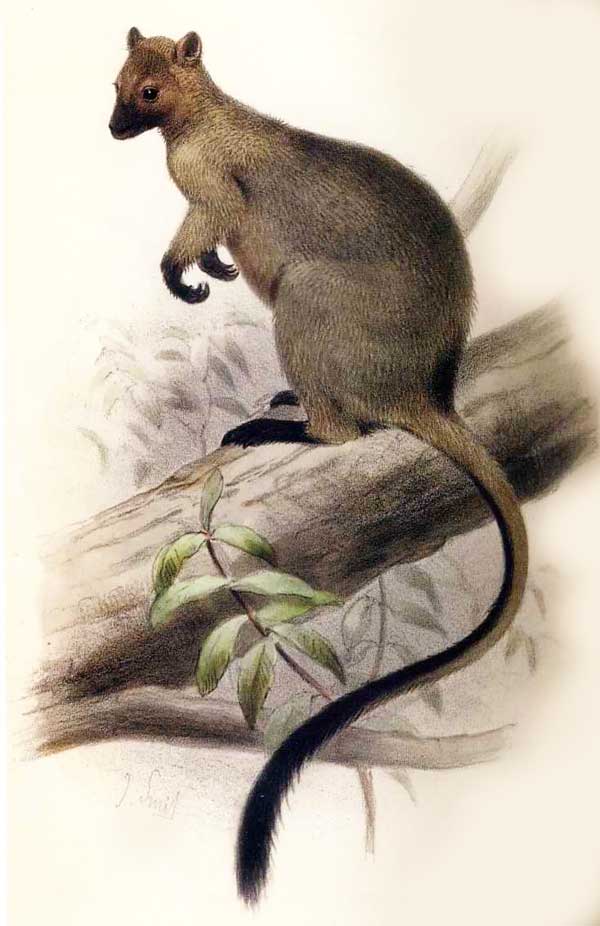
Dendrolagus bennettianus
Superregnum: Eukaryota
Cladus: Unikonta
Cladus: Opisthokonta
Cladus: Holozoa
Regnum: Animalia
Subregnum: Eumetazoa
Cladus: Bilateria
Cladus: Nephrozoa
Superphylum: Deuterostomia
Phylum: Chordata
Subphylum: Vertebrata
Infraphylum: Gnathostomata
Megaclassis: Osteichthyes
Cladus: Sarcopterygii
Cladus: Rhipidistia
Cladus: Tetrapodomorpha
Cladus: Eotetrapodiformes
Cladus: Elpistostegalia
Superclassis: Tetrapoda
Cladus: Reptiliomorpha
Cladus: Amniota
Cladus: Synapsida
Cladus: Eupelycosauria
Cladus: Sphenacodontia
Cladus: Sphenacodontoidea
Cladus: Therapsida
Cladus: Theriodontia
Subordo: Cynodontia
Infraordo: Eucynodontia
Cladus: Probainognathia
Cladus: Prozostrodontia
Cladus: Mammaliaformes
Classis: Mammalia
Subclassis: Trechnotheria
Infraclassis: Zatheria
Supercohors: Theria
Cohort: Metatheria
Cohors: Marsupialia
Cladus: Australidelphia
Cladus: Eomarsupialia
Ordo: Diprotodontia
Subordo: Macropodiformes
Familia: Macropodidae
Subfamilia: Macropodinae
Genus: Dendrolagus
Species: Dendrolagus bennettianus
Name
Dendrolagus bennettianus De Vis, 1887
Type locality: Australia, Queensland, Daintree River
Holotype: QM J307
References
Dendrolagus bennettianus in Mammal Species of the World.
Wilson, Don E. & Reeder, DeeAnn M. (Editors) 2005. Mammal Species of the World – A Taxonomic and Geographic Reference. Third edition. ISBN 0-8018-8221-4.
Proc. R. Soc. Queensl. 3(1886): 11 [1887].
Wilson, D.E. & Reeder, D.M. (eds.) 2005. Mammal Species of the World: a taxonomic and geographic reference. 3rd edition. The Johns Hopkins University Press: Baltimore. 2 volumes. 2142 pp. ISBN 978-0-8018-8221-0. Reference page.
IUCN: Dendrolagus bennettianus De Vis, 1887 (Near Threatened)
Vernacular names
English: Bennett's Tree-kangaroo
français: Dendrolague de Bennett
magyar: Bennett-kúszókenguru
日本語: ベネットキノボリカンガルー
polski: Drzewiak Bennetta
Bennett's tree-kangaroo (Dendrolagus bennettianus) is a large tree-kangaroo. Males can weigh from 11.5 kg up to almost 14 kg (25 to 31 lbs), while the females range between about 8 to 10.6 kg (17.6 to 23 lbs). They are very agile and are able to leap 9 metres (30 ft) down to another branch and have been known to drop as far as 18 metres (59 ft) to the ground without injury.[3]
Description
Bennett's tree-kangaroo mother and baby
Like other tree-kangaroos it has longer forelimbs and shorter hindlimbs than terrestrial kangaroos and a long bushy tail. It is mostly dark brown above and lighter fawn on chin, throat and lower abdomen. The forehead and muzzle are greyish. The feet and hands are black. The tail has a black patch at the base and a light patch on the upper part. The ears are short and rounded.
Habitat
This very elusive (or "cryptic") tree-kangaroo is found in both mountain and lowland tropical rain forests south of Cooktown, Queensland to just north of the Daintree River; an area of only about 70 km by 50 km (44 miles by 31 miles). It is also occasionally found in sclerophyll woodlands. It lives almost completely on the leaves of a wide range of rainforest trees, notably Schefflera actinophylla (the umbrella tree), vines, ferns and various wild fruits.[4]
Diet
The Bennett's tree-kangaroo is a herbivore. It mostly eats leaves off 33 different plant species.
Now that it is rarely hunted by Aboriginal Australians, its main predators are pythons and the dingo. It is thought to be the closest tree-kangaroo to the ancestral form.[5][6]
Conservation status
Although the IUCN still rates the status of Bennett's tree-kangaroo as "near threatened",[2] its numbers seem to be increasing and its range expanding. Sightings have become far more common in recent years. In 2006 a dead specimen was found along Amos Bay Road, just south of Cooktown. The increases in numbers and range are likely because most of its range is now protected under World Heritage legislation, and it is no longer hunted by Indigenous Australians. Both Roger Martin and Lewis Roberts, two of the world's top experts on this species, agree that it should now be classified as "secure."[4]
Footnotes
Groves, C. P. (2005). Wilson, D. E.; Reeder, D. M. (eds.). Mammal Species of the World: A Taxonomic and Geographic Reference (3rd ed.). Baltimore: Johns Hopkins University Press. p. 59. ISBN 0-801-88221-4. OCLC 62265494.
Winter, J.; Burnett, S.; Martin, R. (2019). "Dendrolagus bennettianus". IUCN Red List of Threatened Species. 2019: e.T6426A21957127. doi:10.2305/IUCN.UK.2019-1.RLTS.T6426A21957127.en. Retrieved 19 November 2021.
Cronin (2000).
Martin (2005).
Martin et al. (1996), pp. 94–95.
Nguyen, H. (2000). "Dendrolagus bennettianus". Animal Diversity Web. Retrieved 2006-11-25.
References
Wikispecies has information related to Dendrolagus bennettianus.
Wikimedia Commons has media related to Dendrolagus bennettianus.
Cronin, Leonard (2000). Australian Mammals: Key Guide (Revised Edition). Envirobooks. Annandale, Sydney, Australia. ISBN 0-85881-172-3.
Martin, Roger, et al. (1996). Tree Kangaroos: A Curious Natural History. Reed Books, Port Melbourne, Vic., Australia. ISBN 0-7301-0492-3.
Martin, Roger (2005). Tree-kangaroos of Australia and New Guinea. CSIRO Publishing, Collingwood, Vic., Australia. ISBN 0-643-09072-X.
Retrieved from "http://en.wikipedia.org/"
All text is available under the terms of the GNU Free Documentation License

